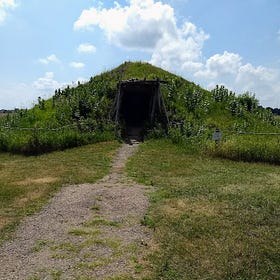West With The Wagons (8): Need Any Stamps Today?
The Post Office in the Middle of Nowhere. On the Trail of the Gold Rush, We're All Surprised.
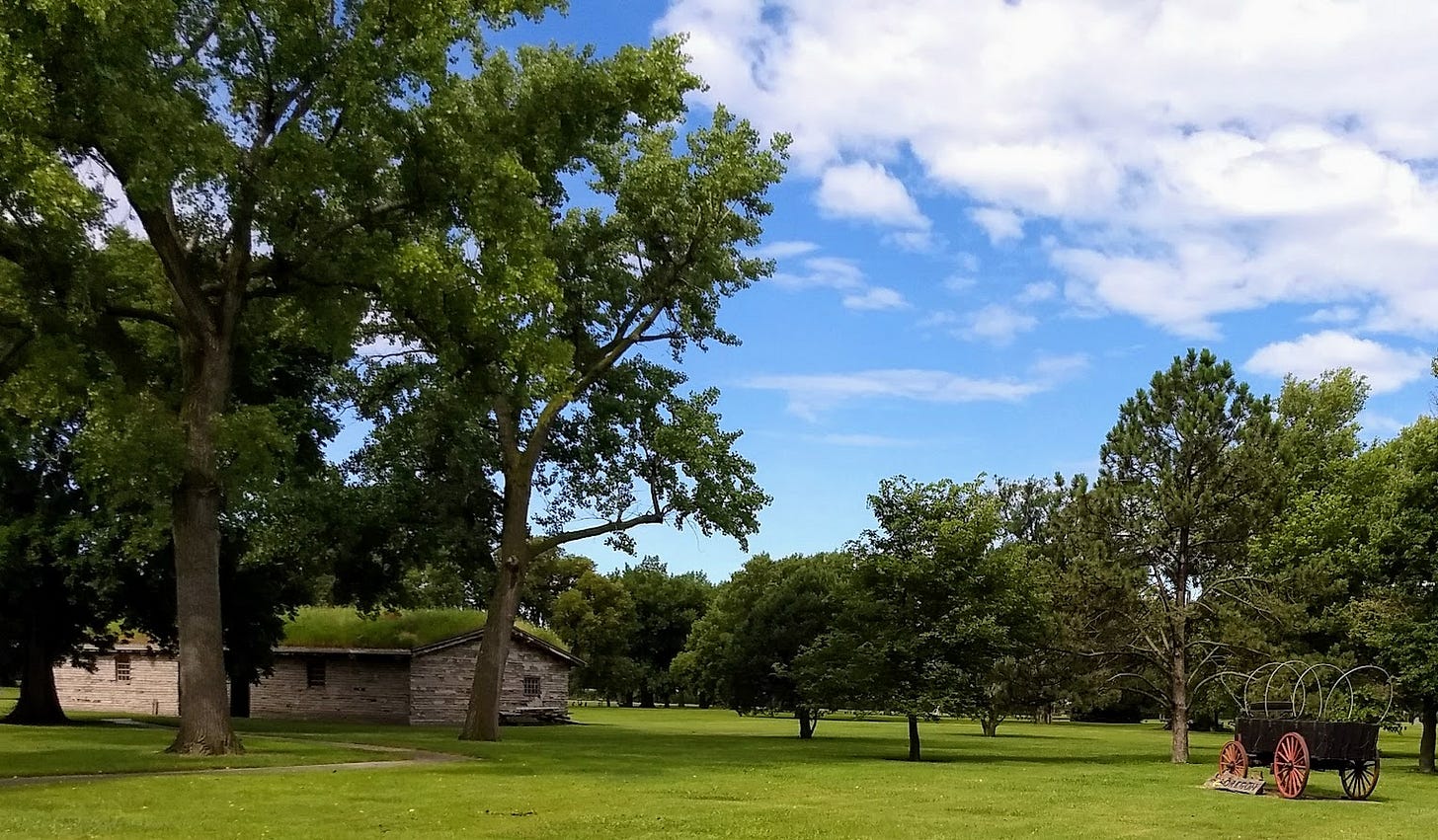
Continued From:
West With The Wagons (7): Misimpressions
Many Americans' understanding of westward migration has jumped practically overnight from "pioneer heroes in covered wagons bravely fighting off Indians" to "evil white supremacists colonizing the Plains", Others dismiss anything that Mrs. Grabowski didn't teach in 3rd grade as "revisionism." I'm asking us to slow down a bit, because the past, as ever, is complicated, and the more we get that, the more real and relevant it becomes. Ah, let me just show you!
How Long Is This Post? About 5,500 words, or twenty-five minutes
Dear Nonnie Friend,
In 1849, Gold Rushers had left the frontier towns of Independence and St. Joseph, after filling their wagons for the journey West, which now took them along the looooong Platte River Valley.
Traveling from the frontier to today’s destination took them at least three weeks, most of them walking.
About 170 years later, the same journey took Hoosen and me about three hours (plus stops).
The whole way, we were anxious about trucks and Florida drivers.
The whole way, 1849 migrants were anxious because education, prejudice, sensational newspaper accounts, and gun-selling merchants’ handouts, had impressed upon them that Indians would try to kill them.
Even travelers who had met perfectly matter-of-fact and friendly Native people were nervous that those were good Indians, and that bad Indians still lurked ahead. Confirming their prejudices? Early on the journey, they learned that Indians stole livestock, a subject I tackled in Part 7, above.
Not surprisingly, even as they traveled in groups (called wagon trains) for protection, migrants felt vulnerable to attack in those early weeks on the trail.
And they were being attacked.
Just not by Indians.
“Our Enemies Hovering Over Us, and Whetting Their Daggers”
Those are the words of posh Irishman William Kelly, on his way to California in 1849. He had soon got fed up with traveling the Platte River Valley through what’s now Nebraska. He found the river bizarre and frustrating, because it sprawled across the flat landscape (Platte means “flat”) in ribbons of varied depth: Chin-deep in so many places, but only a few inches in others, which made the Platte impossible to travel by boat.
Millions of gallons of water, Kelly moaned, and yet the Platte was useless for transportation: It couldn’t carry even the smallest canoe. If the Platte were a real river, he grumbled, it would make the journey to California a whole lot easier.
The Platte River was lousy for water transportation, but it wasn’t useless to those crossing the Great Plains by land. The river provided a clear map West, plus essential water for people, wild game, and livestock. But even the water came with problems. Lots and lots of problems: Millions of armed attackers.
Each night on the Platte, William Kelly, his fellow Gold Rushers, and their teamsters (working-class guys, white, black, Latino, who drove the animals and wagons) put up their tents for the night. And each night, they found a “monster meeting” of mosquitoes waiting.
Without anti-bug sprays, not yet invented, the guys were soon attacked by the mosquitoes’ “poisoned javelins”. I probably don’t need to tell you that bites led to swellings and “irresistible itching”, and then scratching, which infected their wounds.
“I have never bore or suffered so unbearable an infliction [sic],” Kelly wrote in his memoir. At one point, he had so many bites on his forehead, he found wearing his hat too painful. He noticed how mosquitoes like the taste of some people more than others: “There are those whose blood they do not relish, while on that of others they banquet like gluttons.”
Kelly and his fellow travelers, an all-male outfit, took dips in the river for relief, only to find the mosquitoes waiting for them when they got out of the water. Two guys decided to bet each other in a contest: They stripped naked and lay on the river bank, puffing on cigars in hopes of chasing off the mosquitoes with the pungent smoke. The bet was on which man would last the longest.
“Both held out manfully for five minutes,” Kelly wrote. The one who gave up first, as he stood, leaned over and “playfully” applied the lit end of his cigar to his friend’s butt. The guy yelped and jumped to his feet, thinking that an extra-large mosquito had got him.
I bet everyone (well, almost everyone) in Kelly’s party got a laugh from that! Hey, they were desperate for a bit of entertainment.
The Platte was so huge, so boring, Kelly wrote, it was hard to feel like you were making any progress, “so much is the unpracticed eye deceived in surveying those interminable plains.”
In other words, it was hard to know where you were in the journey when the Valley ran on forever, and it all looked the bloody same.
So spotting a building ahead of you, and a US flag fluttering in the wind, must have been a welcome sight to travelers, and, to at least a few, a gobsmacking one.
What on earth was a post office doing in the middle of nowhere?
Didn’t see that coming!
Are We There Yet?
I’m a British historian of early America (mostly the 17th and 18th centuries), and I had never known much about the Gold Rush before 2018, despite living in California in my teens and twenties.
So in 2018, the first time I dipped into a collection of published diaries from the 19th century Westward trails, I shared the amazement of a woman who came upon a post office on the Prairies. That’s actually what got me hooked on this subject. Good grief, I thought, what else don’t I know?
I know now that many migrants had guidebooks, so the surprise is that this traveler was surprised. I wonder who she was? I didn’t take notes, and haven’t been able to find her again in my books, but thanks to her, I can share with you that the Westward migration isn’t what most of us think.
People prepared their wagons for their journeys West as if they were going to Mars, much to the joy of merchants in the “jumping off towns”, like Independence, St. Joseph, and Council Bluffs. They brought food, water bottles, animal feed, equipment, anything they thought they might need in California, and even heirlooms, including furniture. The wagons were packed to the gills.Makes sense, right? Yeah. Thinking for yourself without evidence doesn’t yield the greatest results. As we will see.
Travelers starting out West were probably surprised to find the trails crowded at first. But the crowds of wagons, animals, and people soon thinned, as people and wagons, while headed in the same direction (West) spread out across the vast landscape after leaving the “jumping off” towns.
The reality of their journey was constantly changing, and far different from what we, Hoosen and me—and they— could possibly have imagined, in every way.
Even in 2018, with our speedy luxury gerbil-powered Honda wagon, and our hotel tents, Hoosen and I —not having done as much reading on the subject as I should have, and would later—were constantly surprised on this journey.
And good God, the Platte Valley is long and boring. After our leisurely visit to the Stuhr Museum on Grand Island (which William Kelly in 1849 called “the largest river island in the universe”) , Hoosen and I got back on the freeway, because we wanted to get to our campsite hotel before nightfall.
Cruising by, we passed miles and miles of cornfields, occasional houses and small towns, and not much else. It didn’t feel like 1849 at all, but at least we were almost always in sight of the line of spindly little trees and bushes that line the Platte River’s banks. There really aren’t many trees in the valley, and that was even more true in 1849.
Late in the afternoon, as we came into the small city of Kearney, Nebraska, we saw this:
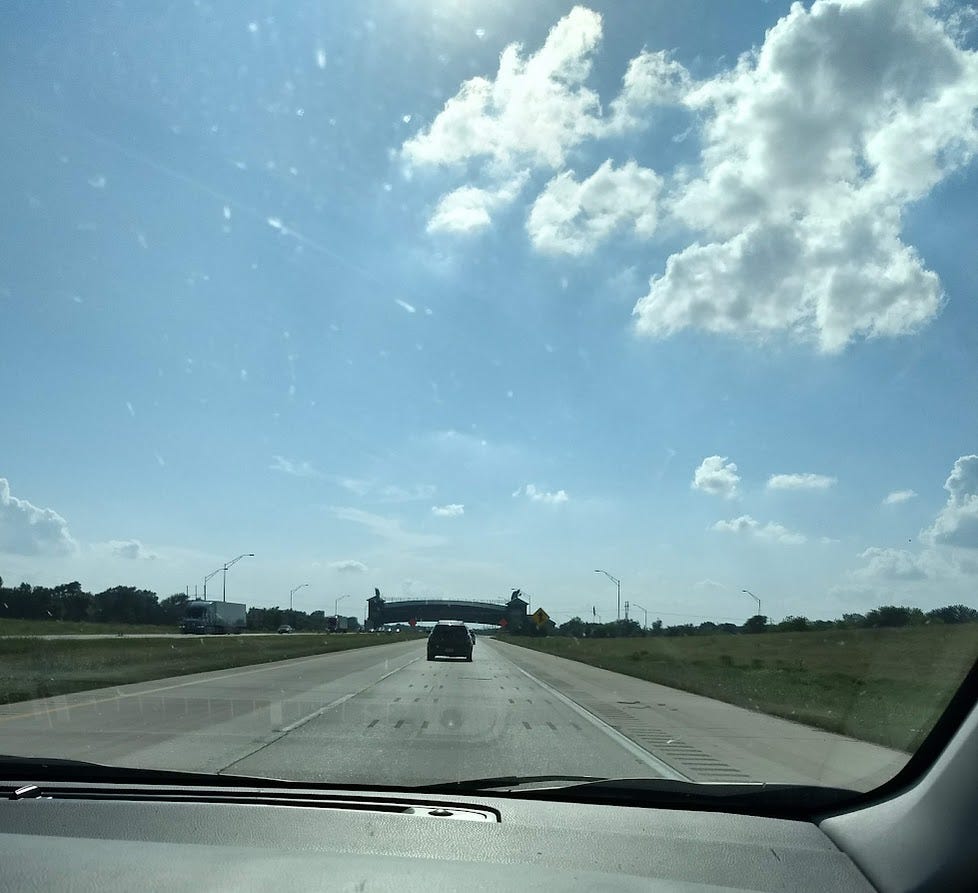
Wow. This was unexpected! “What the heck is that?” I said to Hoosen, a comment rather than a question, and scrambled to consult my phone.
That arch over the freeway is a museum. No kidding. It’s called the Archway, or, to give it its proper (and far too long) name, it’s the Great Platte River Road Archway Monument.
The Great Platte River Road, by the way, is what amateur historian/trails nerd Merrill Mattes, back in 1969, called the stretch of the California-Oregon-Mormon trail that runs between this area, and the end of the Plains in Wyoming.
For the 19th century migrants, there were no alternate routes on this part of the journey, as there would be in the Far West. This was the way everyone came. Mattes argued this stretch was the most important route in American history (he might have a point, although he and I might have argued over why), so the Archway sort of marks the entrance to the “Great Platte River” Road”, even though it wasn’t a road at all. That’s a bit like the huge metal arch in St. Louis welcomes us to the imaginary line marking the start of what we now think of as the West.
It’s all about stories. Imagine if Indian nations had as much funding and support in telling their version of Westward migration through monuments. Very different. I can tell you that the best museums I’ll show you on the way do help us get alternative stories, and in much more than a simple “here it is” monument—but, unlike with monuments, we do have to make the decision to go inside museums.
I can’t remember whether I knew about Nebraska’s Archway museum before seeing it, but I didn’t know ahead of time about its unusual shape and location, that’s for sure. Maybe I had already decided against visiting the museum because it sounded a bit too Disney even for me (and because I wasn’t writing NBH in 2018, so less reason to go inside).
Either way, the Archway museum was closed when we got there.
Hoosen and I stopped by the Archway again in 2022, on our way West once COVID restrictions were lifted, and, once again, we were too late in the day: Closed again.
BUT, I say, BUT in 2022 a public chili cookoff was happening in the museum meeting room that day, and the gift shop was open, so at least we got to a chance to stock up the wagon. Alas, the gift shop, while big, was not great, heavy on unrelated tat, light on books, and even the T-shirts weren’t fun.
So here’s a glimpse of the Archway museum lobby, with closed-off escalator to the museum, plus a closer look at the outside (looking east) complete with enormous and tacky fake eagle atop on the tower on the left. You can blow up the pics by hovering/clicking:
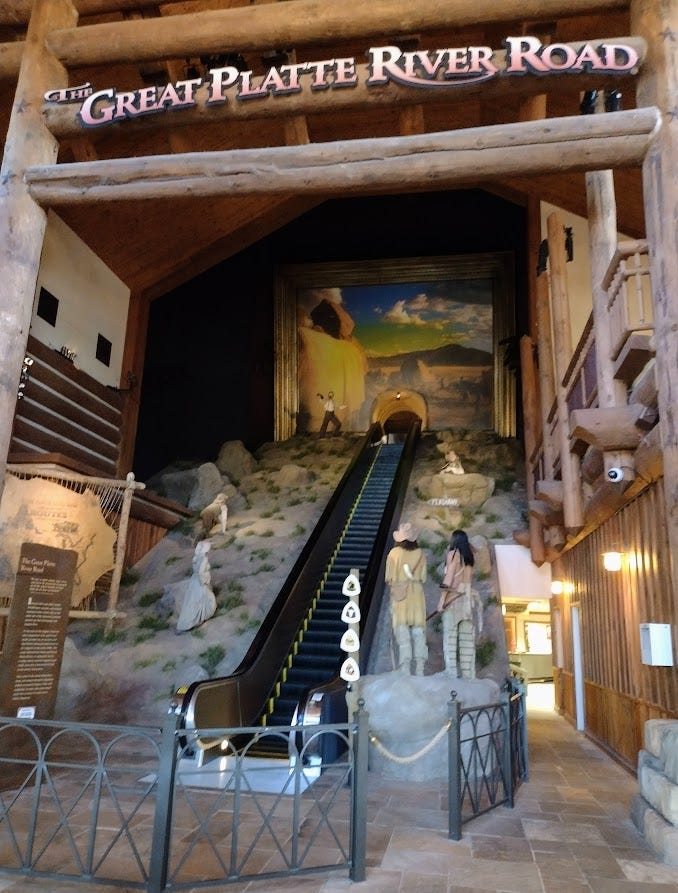
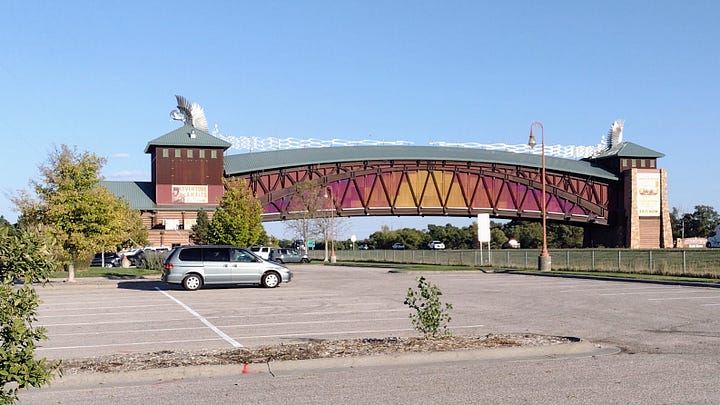
Rising up the escalator, museum visitors pass 19th century migrants climbing uphill, not that there was a lot of uphill climbing in the flat-as-a-pancake Platte River Valley, but never mind. I love museums with mass appeal, and if you do too, stay tuned. If I ever catch the Archway Museum open, I’ll plunk down the money (thank you, Nonnies, for all your help—it matters) and take a look. I want to know if it’s any good as public history.
Annette’s Aside: I haven’t yet been inside the Archway. But, based on what I’ve read, I wouldn’t arrange a trip around it if I were you, unless you live fairly close. It is a bit pricy, and as we will see, there are better options (better, as in, at least as much fun, probably more informative, and FREE).
Good news? At NBH, I’m committed to showing you all sorts of museums, and the best ones are most often free to enter, because they’re operated as a public service by the US federal government, and sometimes by states.
I know, right? After years of being told that private enterprise does things better, and that we get what we pay for, that doesn’t work for most museums. I’ll say it again: Most of the very best museums in the US are free, and operated by government.
Sorry, conservative friends, but that’s my honest and carefully considered judgment, based on experience not bias, and if you have read NBH for a while now, you know I visit all kinds of museums.
Why don’t I just stick to showing you the best examples of the museum genre? Because all of us inevitably stumble into every kind of museum—free and expensive, great, mediocre and boring, and those so bad they’re loads of fun.
So I try to show you how to make the the most of them all, while giving a hard time to museums that don’t even try, or try too hard, or just get things horribly wrong. By the way, conservative friends, I have been to the Richard Nixon Library several times, and even based a lesson on its museum that surprised my students, regardless of their politics. I’ll write about that sometime.
And again on the bright side, conservative friends, you may need engaging museums to which to take kids, to supplement dire school social studies and history curriculum, which is true even if your kids or grandkids or nieces and nephews and godchildren attend private school. Why? Because (honestly?) no matter our politics, we need more people interested in history and thinking historically. Learning how to think matters, now more than ever.
Hoosen and I had driven that day from Omaha. Nebraska, a large city west of the Missouri River, right across from Council Bluffs, Iowa. The city of Omaha (named for a local Native people whose land was taken over) didn’t exist until 1854.
Our journey this day in 2018 had been about 200 miles, but since we had stopped a lot, it took us longer than Google’s estimate of two and half hours. Still a lot shorter than, say, three weeks, or a month.
Hoosen and I pitched our tent checked into our hotel close to the Archway, in the small city of Kearney, Nebraska (founded 1873, so not there in 1849). Like most westward migrants who camped in the area in 1849, and modern visitors to Kearney, we didn’t linger. The next morning, we packed our wagon (threw our cases in the back), and headed for the place after which the modern city is named: Fort Kearny.
That’s not a typo: This 19th century military base was named for noted soldier Col. Stephen Kearny, but since his last name looks misspelled, most people added an “e” to it, and that’s why an “e” came to be in the city’s official name.
Freeway and city are on the north side of the Platte, which was mostly traveled by people on the Mormon Trail, headed from Council Bluffs to Salt Lake City. Having been harassed, attacked, and murdered for being Mormons, which is why they were going West, Mormons were keen to avoid other migrants, who traveled on the south bank.
So to get to Fort Kearny, we traveled south, back across the several strands of the Platte—a much easier journey than in 1849, thanks to the many ugly but practical road bridges in place today.
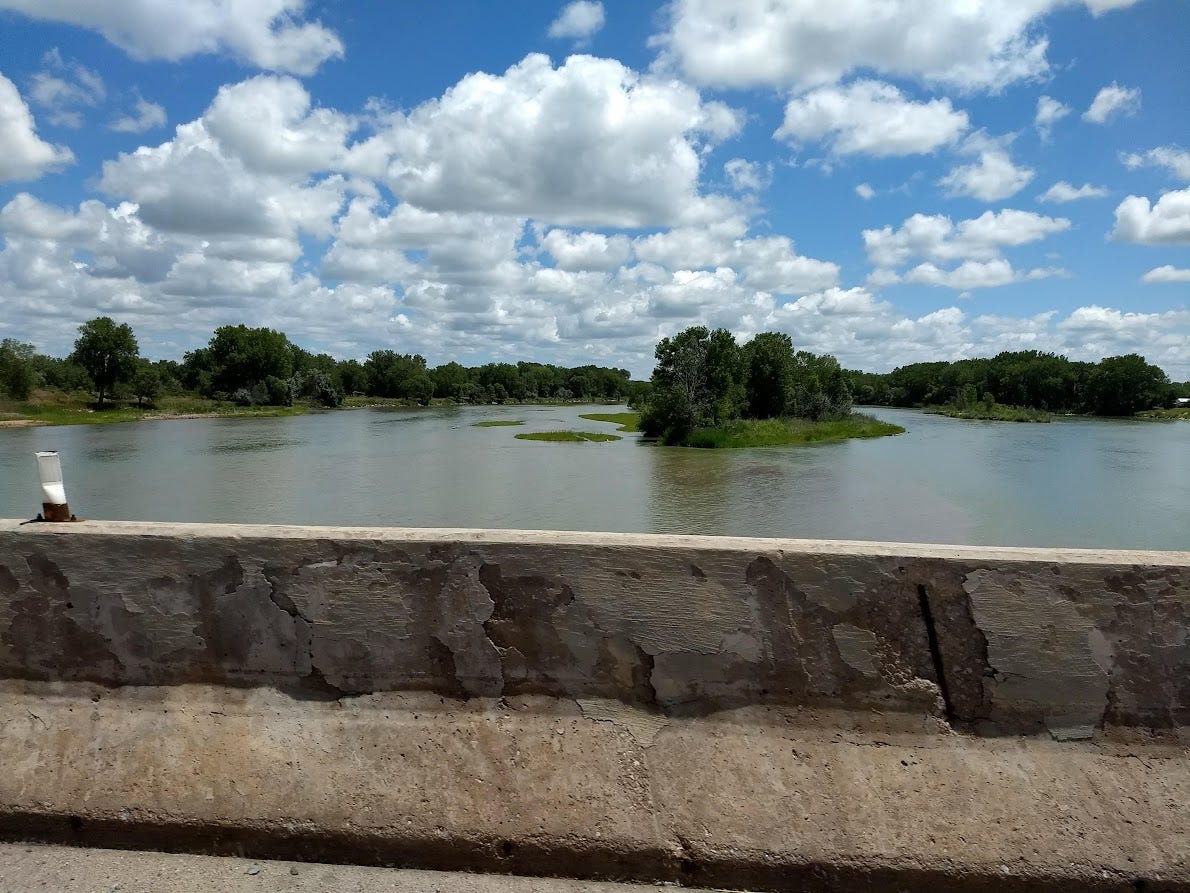
Fort Kearny didn’t impress posh Irishman William Kelly in 1849, even though you would think it should have been a welcome sight to him after miles and miles of tedious travel though the “interminable plains.”
Gotta say, I love William Kelly, even though his bigotry against, well, practically everyone he meets makes me wince. Hey, being a person of his time was a real thing, and if we cancel everyone with a prejudice, my job and human life is pretty much done. And anyway, William Kelly, writing in the great tradition of the Irish (and Scots!), doesn’t feed us mealy-mouthed fake praise. No toxic positivity from this guy. Here he is, happily judging Fort Kearny:
“We reached Fort Kearney early in the evening—if fort it can be called—where the States have stationed a garrison of soldiers, in a string of log huts, for the protection of the emigrants, and a most unsoldierly-looking lot they were—unshaven, unshorn, with patched uniforms and lounging gait.”
Far from helping supply the travelers, Fort Kearny’s soldiers asked to buy provisions from Kelly and his companions: Flour, sugar, and most especially whisky. The troops offered Kelly a massive sum for the booze, a dollar for half a pint, but, Kelly recalled, “we had none to sell even at that tempting price.”
Bearded, long-haired slovenly US soldiers lazing about sipping whisky? What was going on? As it happens, a lot.




